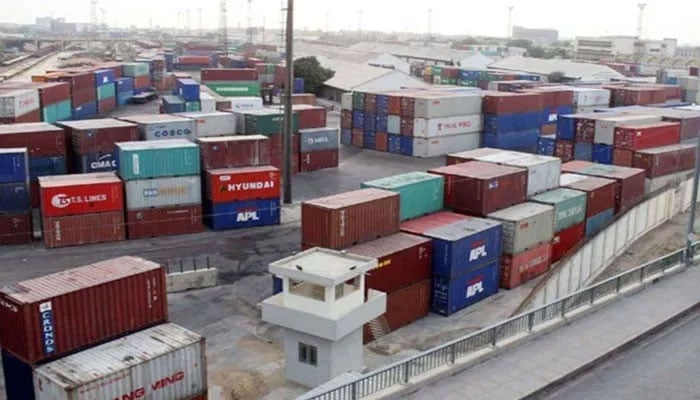Mitigating export barriers
The list includes high energy tariffs, delays in tax refunds, high costs and shortage of financing
For the last couple of years, the government has been persuading the industry to enhance the country’s exports to $50 billion in the next five years. The industry, however, has its own litany of issues that need to be resolved before exports can take an upward trajectory.
The list includes high energy tariffs, delays in tax refunds, high costs and shortage of financing, sustainable government policies particularly those on the import of raw materials and so on. A workable solution to the perceived barriers to exports has yet to be found even after years of negotiations.
PIDE, in its landmark report ‘What are the Factors Making Pakistan’s Exports Stagnant’, released in 2023, covers a complete spectrum of barriers to exports. The report shows that several concerns can be implemented by the industry and no government intervention is required. Lack of R&D at the firm’s level, low productivity of firms relative to India and Bangladesh, and the unavailability of skilled and educated labour are all within the industry’s capacity to improve.
If taken up in earnest, these issues may compensate for some of the pending concerns with the government. Take the case of low productivity of firms and lack of skilled and educated labour – both factors impact production costs. Whether or not we can export depends on our production costs relative to our competitors. This is the crux of the problem. To catch up or stay ahead for long in the increasingly intense race for a competitive edge, we should, therefore, be in a position to measure the productivity of our industrial plants. In the current scenario, productivity is all about the productivity of machines and labour.
In my experience with the industry, there is hardly any plant in Pakistan that has a mechanism for measuring the productivity of machines and labour.
India and Bangladesh religiously measure these two criteria. Universities in Bangladesh are practically embedded in the industry to guide enhanced machine productivity.
Machine and labour productivity are both identified by three identical factors. The first is availability – how often is the machine or labour available for production? The second factor is machine and labour performance – is the machine producing at the rate of which it was designed to produce? Are manufacturing cycles slow? Does labour strictly follow written work instructions? The third factor is the quality of the products being produced.
The product of these three factors is the gold standard of manufacturing productivity and is known as Overall Equipment Effectiveness (OEE) and Overall Labor Effectiveness (OLE). The world standard for both indices is 85 per cent. Each element of OEE / OLE accounts for a different kind of waste in the production process. OEE, thus, is a direct measure of the earning capacity of a plant.
Measuring OEE / OLE is a manufacturing industry best practice. It is the single best metric for identifying waste, losses, benchmarking progress, and productivity of manufacturing plants.
In international markets, the competition revolves around the cost of production, which is determined basically by the identification and removal of waste. Measurement of the three plant effectiveness factors helps, both to identify and remove waste.
Energy tariffs thus become a secondary issue, because they can be offset sharply by improving plant effectiveness indices. Our fixation with energy costs has blinded our industry to the developments in plant management and how these have been used by our competitors to overcome various obstacles to lead the export race.
Bangladesh for example imports all of its raw materials yet leads the textile exports race. It’s the skills imparted to women (over three million) and the involvement of its universities in enhancing machine productivity that enabled the country to overcome the effects of the high cost of imports.
Industry around the globe, in particular India and Bangladesh, have reaped huge benefits using the insights gained some forty years ago about factors leading to increased productivity, market share and profitability. All with no additional capital investments but an aggressive application of plant effectiveness factors. It’s time the industry in Pakistan undertakes a benchmarking exercise on plant management to mitigate the effects of high energy tariffs.
The writer is a freelance contributor and can be reached at:
miansalimuddin@gmail.com
-
 Why Claude Is Gaining Momentum In Revolutionizing The AI Landscape
Why Claude Is Gaining Momentum In Revolutionizing The AI Landscape -
 Cheaper Cars, Fewer EVs: Trump Administration Shifts ‘auto Policy’ Focus
Cheaper Cars, Fewer EVs: Trump Administration Shifts ‘auto Policy’ Focus -
 Meghan Markle Takes 'breadwinner' Role In Prince Harry's California Life
Meghan Markle Takes 'breadwinner' Role In Prince Harry's California Life -
 Type 2 Diabetes Hidden Trigger In Daily Food Revealed
Type 2 Diabetes Hidden Trigger In Daily Food Revealed -
 Vertical Tabs Coming To Google Chrome
Vertical Tabs Coming To Google Chrome -
 Jane Seymour Reveals THIS Beloved Romance Was 'worst-reviewed' Movie Ever
Jane Seymour Reveals THIS Beloved Romance Was 'worst-reviewed' Movie Ever -
 European Leaders Slam Trump’s Tariff Threat Over Greenland As ‘unacceptable’
European Leaders Slam Trump’s Tariff Threat Over Greenland As ‘unacceptable’ -
 Princess Eugenie Leaves Father Andrew 'devastated' With Big Step: 't's Brooklyn Beckham Level'
Princess Eugenie Leaves Father Andrew 'devastated' With Big Step: 't's Brooklyn Beckham Level' -
 Nova Scotia Snow Storm Warning Issued As Heavy Snow Moves In
Nova Scotia Snow Storm Warning Issued As Heavy Snow Moves In -
 Vancouver Canucks 2025-26 Season: Adam Foote’s Future Under Early Scrutiny
Vancouver Canucks 2025-26 Season: Adam Foote’s Future Under Early Scrutiny -
 Gabriel Diallo Vs Alexander Zverev: Rising Canadian Eyes Major Upset Opportunity
Gabriel Diallo Vs Alexander Zverev: Rising Canadian Eyes Major Upset Opportunity -
 Bo Nix Injury Update: Broncos Quarterback Fractures Ankle Against Bills
Bo Nix Injury Update: Broncos Quarterback Fractures Ankle Against Bills -
 Oilers Vs Canucks: Why Edmonton Is Without Leon Draisaitl
Oilers Vs Canucks: Why Edmonton Is Without Leon Draisaitl -
 49ers Crushed As Kenneth Walker III Leads Seahawks To 41-6 Win
49ers Crushed As Kenneth Walker III Leads Seahawks To 41-6 Win -
 Canadiens Star Lane Hutson Makes History With 100th NHL Assist
Canadiens Star Lane Hutson Makes History With 100th NHL Assist -
 Bridgerton’s Claudia Jessie Says Her Real-life Style Is Nothing Like Eloise’s
Bridgerton’s Claudia Jessie Says Her Real-life Style Is Nothing Like Eloise’s




